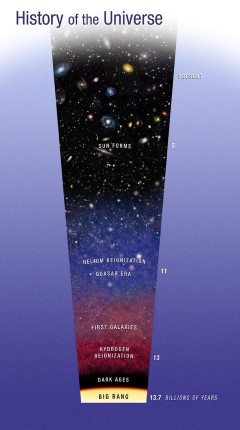History of the Universe: A diagram of the evolution of the Universe from the big bang to the present, with two epochs of reionization. A few key events in the history of Universe are illustrated in the caption. The numbers along the right edge of the sketch indicate the age of the various events.
Credit: NASA; ESA; A. Feild, STScI
It’s important to realize that the whole history of the Universe is laid out in front of us to observe. If an object is two billion light-years away, that means I’m seeing it the way it was two billion years ago, because it took two billion years for the light to reach me. By looking at objects at different distances, I can see what the Universe looks like today, one billion years ago, two billion years ago, five billion years ago, even ten billion years ago. But, those objects that are ten billion light-years away are really faint, so you need a really powerful telescope to see them. If I could actually make all the observations, the whole history of the Universe is right there for me to observe. That’s what we’re trying to understand: what are the overall physical principals that control the nature of the Universe? To find that out, we need to see how the Universe has changed with time. That’s why there’s always a push for bigger and bigger telescopes to look at fainter and fainter objects, so we can look further back in time.
When Hubble was built, nobody thought the Universe was accelerating. You would have been laughed out of the room if you’d said that the Universe was accelerating. Now it is common knowledge that the Universe is accelerating. Before the 1990s it was generally thought that the gravitational force of the total amount of matter in the center of the Universe would retard the motion of the matter at the edge of the Universe, causing a deceleration for the latter. Things change. Now it’s common knowledge, but what’s common knowledge today, maybe in 30-40 years it turns out we didn’t get it right. That’s okay, that’s the way science goes forward. And it requires new technology to continually move forward as well.
I remind people that for most of the nineteenth century all of the most brilliant minds in the world were convinced there was an ether for the propagation of electromagnetic radiation. The idea that light could propagate by itself was absurd, impossible. “A wave cannot propagate without a medium.” That was a basic rule of physics that everybody knew was true. To say otherwise would have meant you got an F on your test. In fact, the critical experiment, known as the Michelson-Morley experiment (end of the 19th century), to confirm the existence of the ether did not, and it was considered a failure. It was some years before it was realized that this was the correct outcome! As in the cases of the expanding Universe and the amount of matter in the Universe, ideas commonly thought to be true, turn out not to be true decades later.


